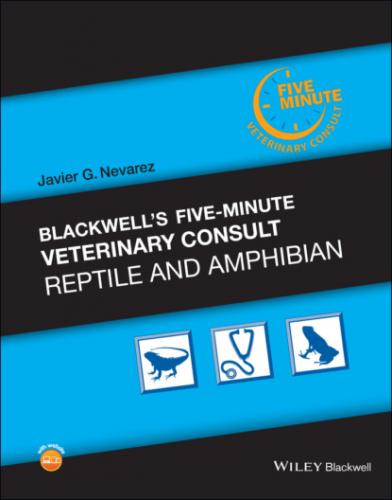Reproduction of reptiles occurs primarily as vivipary (give birth to live young) or ovipary (lay eggs). Some species are parthenogenic (asexual reproduction, species are females only). It is important to know that intact reptiles may show reproductive behaviors even in the absence of a mate. This is especially important in oviparous species, which can develop and lay infertile eggs, to the surprise of the owner. It is important to ensure proper calcium intake in these species to prevent dystocia problems. Some species will also decrease their activity and will eat less or become anorectic during certain times of the year, all associated with reproductive activity.
Knowledge of internal anatomy is critical for surgery and radiographic interpretation. Reptiles do not have a diaphragm, so the viscera and the lungs are found within the same cavity, the coelomic cavity. Radiographically, the lungs may be observed to occupy over 50% of the coelomic cavity, especially during inspiration. The detail of the viscera is usually less rewarding, and the goal is to identify any well‐demarcated masses that may appear out of place within the cavity. In females, follicles and/or eggs may be observed if they are reproductively active. The bony opacity should appear similar to that observed in mammals. Reduced bone opacity may be an indication of metabolic disease. Mineralization of the kidneys, joints, or other viscera is indicative of salt/mineral deposits, usually composed of calcium and causing pseudo gout. Uric acid is radiolucent, so gout does not manifest itself radiographically. In some cases of gout there is a combination of uric acid and calcium crystals, which are visible on radiographs.
Radiographs are also rewarding for identifying fracture of the long bones. Spinal and pelvic fractures may be more challenging to visualize. Ultrasound, fluoroscopy, contrast studies, computed tomography, and magnetic resonance imaging can all be useful in the reptiles, but interpretation is challenging for those unfamiliar with normal anatomy. Some reptile species have a dark pigmentation of their internal mucosa and connective tissues. This pigmentation is normal but can make visualization of organs and tissues difficult during coelioscopy or surgery. Herbivorous reptiles will have a large cecum, which must be avoided during incision of the coelomic cavity. In lizards, there is a ventral abdominal vessel that runs on the ventral midline superficially underneath the skin. For this reason, it is recommended that, in lizards, a paramedian incision be made cranial to the umbilicus, to avoid lacerating this vessel. The vessel splits into a left and right branch at the umbilicus, so a midline incision can be made caudal to this point.
Metabolic activity is the key feature in maintaining health and homeostasis in reptiles. The body temperature of reptiles is primarily regulated by environmental temperature. Reptiles in captivity therefore rely on their caregivers to provide the appropriate temperature for support of normal body functions. All body systems are regulated and stimulated by temperature. Appropriate environmental temperature will lead to a more active metabolism, stronger immune system, and better ability to resist and cope with diseases. Inadequate, low temperature is one of the most common husbandry mistakes when housing reptiles. These colder temperatures can contribute to impaired immunity, respiratory infections, decreased appetite and gut motility, and can eventually lead to a catabolic state that predisposes to disease and even death.
The medical care of the sick reptile is an important consideration if one decides to see them as patients in practice. The first step is to have all the appropriate equipment to care for these patients. While some equipment may be shared by all species, other is more specialized. Box 1 presents a list of equipment and medications that are commonly used for treating reptiles in practice. It is also important to note that the environment provided in a veterinary clinic or hospital is aimed at short‐term housing that will temporarily provide the reptile with appropriate temperature, lighting and nutrition. In the meantime the owner must correct any husbandry issues and prepare the enclosure for when the animal is discharged.
Box 1. Equipment and medications useful for treating reptile patients
Equipment
Gram scale (capacity of 3–4 kg)
Oral speculums (rubber, plastic, and/or wood)
Welding gloves
22‐g, 25‐g, 26‐g needles
1‐cc, 3‐cc syringes
U‐100 30‐unit (0.3‐cc) insulin syringes (BD Consumer Healthcare, NJ, 07417)
BD Microtainer™ tubes for blood collection (0.5 ml capacity) (BD Vacutainer Systems, NJ, 07417)
22‐g, 24‐g, 26‐g intravenous catheters
Glass capillary tubes (with and without heparin) and clay for packed cell volume
1‐inch bandaging material
Sexing probes
Metal feeding tubes with ball tip
Assorted red rubber tubes
Sizes 1–6 cuffed or uncuffed endotracheal tubes
Doppler
Flexible temperature probe and thermometer
Respiratory monitor
Heat lamps
Heating pads and/or forced air warmers (Bair Hugger™, Augustine Medical, Inc., Eden Prairie, MN)
Incubators with temperature control
Thermometer and hygrometer for cages
Food/water bowls and accessories that can be easily disinfected
Appropriate food for the species
UVB lights
Surgical pack with micro‐instruments (ophthalmic instruments)
Otoscope and ophthalmoscope
Drugs and Medications
Topical antibiotics (silver sulfadiazine, SilvaSorb®, Medline Industries, Inc., Mundelein, IL)
Ceftazidime
Ceftiofur crystalline free acid
Ciprofloxacin
Enrofloxacin
Metronidazole
Trimethoprim sulfa drugs
Tetracycline
Fenbendazole
Ivermectin (toxic to chelonians)
Alfaxalone
Ketamine
Medetomidine
